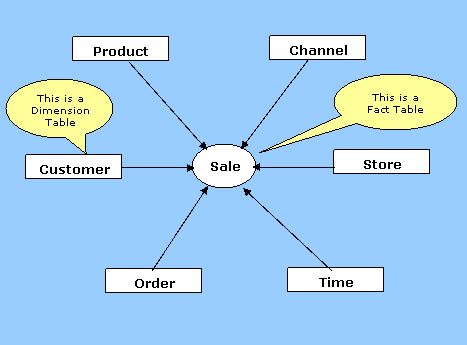What Are Dimensions?
In dimensional modeling, dimensions are descriptive attributes or categorical fields from an entity. They provide context to measurable events (facts). They answer the “who,” “what,” “where,” and “when” of a business process. For example, in a sales data warehouse, while a fact table might store numbers such as sales revenue or quantity sold, the dimension tables contain details like product name, customer demographics, and dates. This separation into facts and dimensions is a core concept behind star and snowflake schemas, which have been popularized by Ralph Kimball and his colleagues for their clarity and performance benefits in analytical workloads.

Inmon’s Top‐Down Approach
- Enterprise Data Warehouse (EDW) in 3NF: Inmon advocates building a centralized, enterprise-wide data warehouse in third normal form. This design focuses on integrating data from various operational systems into a consistent and detailed repository.
https://www.geeksforgeeks.org/third-normal-form-3nf/
- Subsequent Data Marts: From the EDW, subject-area data marts (often implemented as star or snowflake schemas) are created for specific reporting or departmental needs. This ensures that every mart is built on a single source of truth, but it can be time-consuming and may lead to a rigid structure.
- Complexity and Inflexibility: One criticism is exactly —the EDW layer can be complex and require significant upfront investment in time and resources, potentially reducing agility.
Kimball’s Bottom‐Up Approach
- Start with Data Marts: Kimball recommends starting with small, focused data marts built using dimensional modeling (usually star schemas) tailored to individual business processes. These marts are designed for ease of use and rapid delivery of business value.
- Conformed Dimensions: Over time, these marts are integrated using conformed dimensions (shared dimensions across different marts) to ensure consistency across the enterprise. This “bus architecture” allows for scalability and flexibility.
- Raw Data Concerns: While early Kimball implementations sometimes risked losing the raw source data (since the emphasis was on the aggregated, dimensional view), many modern implementations address this by preserving raw data elsewhere or by integrating with approaches like the Data Vault.
Hybrid Architectures and the Modern Data Vault
- Combining Approaches: In practice, many organizations have moved toward hybrid architectures. Rather than choosing strictly between Inmon’s EDW and Kimball’s dimensional marts, a modern approach might use a Data Vault as an intermediate layer.
- Data Vault Benefits: The Data Vault technique allows for storing raw data with full history (including changes and lineage) and can be built incrementally. This offers both the flexibility of Kimball’s quick-to-value marts and the comprehensive historical tracking traditionally associated with Inmon’s EDW.
- Incremental Build vs. All-at-Once: This hybrid approach lets organizations adapt to changing reporting requirements without having to rebuild a massive, all-at-once enterprise model.
Star Schema vs. Snowflake Schema:
- Both Are Dimensional Modeling Techniques: Both star and snowflake schemas are methods for designing the dimensions in a data warehouse.
- Star Schema: In a star schema, dimensions are denormalized—each dimension is contained in a single table, which simplifies queries and improves performance for many reporting tasks.
- Snowflake Schema: In contrast, a snowflake schema normalizes the dimensions further (splitting them into multiple related tables to represent hierarchies). This can reduce redundancy but at the cost of more complex joins.
- No Forced Choice: Neither the Inmon nor the Kimball approach forces you to choose one over the other. The decision is usually based on performance considerations, data volume, ease of maintenance, and specific reporting requirements.
In summary, Inmon’s top‐down method focuses on a comprehensive, normalized enterprise data warehouse from which data marts are derived, whereas Kimball’s bottom‐up approach prioritizes quick delivery via dimensional data marts integrated through conformed dimensions. Modern architectures often blend these methods (using a Data Vault, for example) to preserve raw data and history while still delivering rapid time-to-value. Both star and snowflake schemas are valid techniques for modeling dimensions, and the choice depends on the specifics of the use case.
Key Classifications of Dimensions
Dimensions come in several flavors, and understanding their classification can help you model your data more effectively.
1. Identifier Dimensions
Some dimensions are designed specifically to uniquely identify an entity within your system. For example, a customer dimension might include a unique Customer_ID or Social Security Number (SSN). These identifier dimensions serve as the primary keys used to join fact tables with dimension tables. Their design is often straightforward because their attribute values do not change over time.
In dimensional modeling, a dimension is typically implemented as a table (often called a dimension table) that contains multiple columns—each column representing a specific descriptive attribute of that dimension.
2. Descriptive or Contextual Dimensions
Most dimensions carry descriptive attributes that help analysts filter, group, and label data. Consider a product dimension: along with a product ID, it might include attributes like product name, category, color, and brand. These details make it possible to slice and dice your fact data in meaningful ways.
3. Static (Fixed) vs. Slowly Changing Dimensions
An important distinction in dimensional modeling is whether an attribute is fixed or dynamic over time:
Static (Fixed) Dimensions:
These dimensions contain attributes that remain constant once recorded. Your birthdate or a Social Security Number is a classic example. Such fields are considered immutable—they are “fixed” and serve as reliable identifiers for historical analysis. Because they never change, they are relatively simple to model and maintain.
Example: A “Date of Birth” attribute in a customer dimension is fixed; no matter how many times you query your data warehouse, this value remains the same.Slowly Changing Dimensions (SCD):
In contrast, some attributes evolve over time. For instance, a user’s “favorite food” might change as tastes evolve. These are known as slowly changing dimensions. Managing them can be challenging because you must decide whether to overwrite the old value (SCD Type 1) or preserve the history of changes (SCD Type 2 or Type 3).
Example: Imagine a customer dimension with an attribute “Favorite Cuisine.” If a customer’s preference changes from Italian to Thai, you might either update the record (overwriting Italian with Thai) or, if historical context is important, create a new record version so that historical reports still reflect the original preference at the time of earlier transactions.
4. Additional Dimension Variants
Beyond the basic classifications, modern dimensional models also consider:
Conformed Dimensions:
Dimensions that are consistent and reusable across multiple fact tables. They ensure that different subject areas (such as sales and inventory) can be analyzed together without ambiguity.Junk and Role-Playing Dimensions:
Junk dimensions consolidate low-cardinality flags and indicators into a single table to avoid cluttering the fact table, while role-playing dimensions (like the Date dimension used in multiple contexts) are reused with different roles (e.g., Order Date, Ship Date).
Best Practices for Dimension Design
Use Surrogate Keys
Implement surrogate keys (simple integers or UUIDs) in your dimension tables rather than natural keys. Surrogate keys offer stability—even when natural key values change—and support slowly changing dimension strategies by decoupling the join keys from business logic.
Choose the Right SCD Strategy
Evaluate the importance of historical tracking for each attribute:
- If historical accuracy isn’t critical, a simple overwrite (SCD Type 1) may suffice.
- If preserving history is important (for example, tracking a customer’s evolving address or preference), use SCD Type 2, which creates new rows with effective dates.
- For limited historical tracking (e.g., capturing just the previous value), consider SCD Type 3.
Selecting the appropriate strategy ensures that your data warehouse can support both current operational reporting and historical trend analysis.
Maintain Conformed Dimensions
Design your dimensions to be shared across multiple fact tables. This conformance reduces redundancy and ensures consistency in reporting across different business processes.
Document and Evolve
Dimension definitions may evolve over time as business needs change. Maintain thorough documentation of your dimension structures, the chosen SCD methods, and the rationale behind design decisions. This documentation will prove invaluable when scaling your data warehouse or integrating new data sources.
Modern Considerations in Cloud Data Warehousing
Today’s cloud data warehouses (like Snowflake, BigQuery, and Microsoft Fabric) offer dynamic scalability and powerful query engines that can handle denormalized structures with ease. As a result, the cost–benefit trade-offs that once dictated a rigid star schema are more flexible now. You can often implement more granular SCD techniques without compromising performance. Furthermore, modern ETL/ELT tools enable automation of dimension loading, historical snapshotting, and error monitoring, thereby reducing the engineering overhead traditionally associated with slowly changing dimensions.


